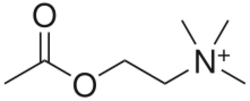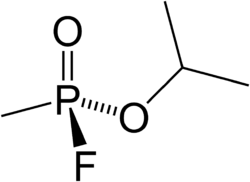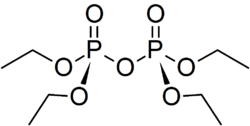Biology:Cholinesterase inhibitor
| Cholinesterase inhibitor | |
|---|---|
| Drug class | |
| Class identifiers | |
| Use | Alzheimer's disease |
| ATC code | N06#N06DA Anticholinesterases |
| Mechanism of action | Enzyme inhibitor |
| Biological target | Cholinesterase |
| Clinical data | |
| Drugs.com | Drug Classes |
| WebMD | MedicineNet |
| External links | |
| MeSH | D002800 |



Cholinesterase inhibitors (ChEIs), also known as anti-cholinesterase, are chemicals that prevent the breakdown of the neurotransmitter acetylcholine or butyrylcholine. This increases the amount of the acetylcholine or butyrylcholine in the synaptic cleft that can bind to muscarinic receptors, nicotinic receptors and others. This group of inhibitors is divided into two subgroups, acetylcholinesterase inhibitors (AChEIs) and butyrylcholinesterase inhibitors (BChEIs).[1][2][3]
ChEIs may be used as drugs for Alzheimer's and myasthenia gravis, and also as chemical weapons and insecticides.[4][5] Side effects when used as drugs may include loss of appetite, nausea, vomiting, loose stools, vivid dreams at night, dehydration, rash, bradycardia, peptic ulcer disease, seizures, weight loss, rhinorrhea, salivation, muscle cramps, and fasciculations.[6][7]
ChEIs are indirect-acting parasympathomimetic drugs.[8]
ChEls are widely used as chemical weapons. Since November 2019 the group of ACheIs known as Novichoks have been banned as agents of warfare under the Chemical Weapons Convention.[9] Novichok agents are neurotoxic organophosphorus compounds and are considered more potent than VX gas, also a neurotoxic organophosphorus compound.[10]
Medical use
While 4 ChEIs are approved in the US for the treatment of Alzheimer's Disease, only three of these are available commercially.[6] The three available are rivastigmine, donepezil, and galantamine, while tacrine is not.[6] They are generally used to treat Alzheimer's disease and dementia.[6] If a benefit occurs, it is generally during the second or third month after starting.[6]
It is difficult to determine which ChEI has greater efficacy, due to design flaws in head-to-head comparison studies.[11]
Pyridostigmine is used in the treatment of myasthenia gravis.[12]
Neostigmine is used in combination with a muscarinic antagonist to reverse the effects of non-depolarizing muscle relaxants e.g. rocuronium bromide
Cholinesterase inhibitor toxicity
Common side effects of one ChEI include insomnia, nausea and vomiting, accidental injury, headache, dizziness, bradycardia, hypotension, ecchymosis, and sleep disturbance.[13]
Binding affinity
Acetylcholinesterase inhibitors
Donepezil, phenserine, huperzine A, and BW284c51 are selective AChE inhibitors.[14][11]
Butyrylcholinesterase inhibitor
Tetra (monoisopropyl) pyrophosphoramide (Iso-OMPA) and ethopropazine are selective BChE inhibitors.[14]
AChE and BChE inhibitor
Paraoxon and rivastigmine are both acetylcholinesterase inhibitors and butyrylcholinesterase inhibitors.[14][11][7]
In 2015, the United States Food and Drug Administration's Adverse Event Reporting System database compared rivastigmine to the other ChEI drugs donepezil and galantamine found that rivastigmine was associated with a higher frequency of reports of death as an adverse event.[15]
Acetylcholinesterase inhibitors and nicotinic receptor modulator
Galantamine might be less well tolerated than donepezil and rivastigmine.[11]
Chemical weapons
Alleged Assassination Attempt
Cholinesterase inhibitors came to a public attention in 2020 when Russian opposition and dissent figure Alexei Navalny was treated in Berlin Charité hospital for alleged poisoning by a Russian-made nerve agent which is known since 2019 as belonging to the Novichok agents subgroup of ChEI.[16]
See also
Further reading
- Institute, National; (UK), Care Excellence (2019-12-27). Cholinesterase inhibitors and memantine for dementia. https://www.ncbi.nlm.nih.gov/books/NBK536484/. Retrieved 2019-12-27.
- Parsons, Chris G.; Danysz, Wojciech; Dekundy, Andrzej; Pulte, Irena (2013-05-09). "Memantine and Cholinesterase Inhibitors: Complementary Mechanisms in the Treatment of Alzheimer's Disease". Neurotoxicity Research (Springer Science and Business Media LLC) 24 (3): 358–369. doi:10.1007/s12640-013-9398-z. ISSN 1029-8428. PMID 23657927.
- Meng, Yan‑Hong; Wang, Pan‑Pan; Song, Ya‑Xue; Wang, Jian‑Hua (2019-03-01). "Cholinesterase inhibitors and memantine for Parkinson's disease dementia and Lewy body dementia: A meta‑analysis". Experimental and Therapeutic Medicine 17 (3): 1611–1624. doi:10.3892/etm.2018.7129. ISSN 1792-0981. PMID 30783428. PMC 6364145. https://www.spandidos-publications.com/etm/17/3/1611. Retrieved 2019-12-27.
References
- ↑ English, Brett A.; Webster, Andrew A. (2012). "Acetylcholinesterase and its Inhibitors". Primer on the Autonomic Nervous System. Elsevier. pp. 631–633. doi:10.1016/b978-0-12-386525-0.00132-3. ISBN 978-0-12-386525-0.
- ↑ Deutch, Ariel Y.; Roth, Robert H. (2014). "Pharmacology and Biochemistry of Synaptic Transmission". From Molecules to Networks. Elsevier. pp. 207–237. doi:10.1016/b978-0-12-397179-1.00007-5. ISBN 978-0-12-397179-1.
- ↑ Colovic, Mirjana B.; Krstic, Danijela Z.; Lazarevic-Pasti, Tamara D.; Bondzic, Aleksandra M.; Vasic, Vesna M. (2013-04-01). "Acetylcholinesterase Inhibitors: Pharmacology and Toxicology". Current Neuropharmacology (Bentham Science Publishers Ltd.) 11 (3): 315–335. doi:10.2174/1570159x11311030006. ISSN 1570-159X. PMID 24179466.
- ↑ "Cholinesterase Inhibitors (Medical Use & WMD)". Tulane University School of Medicine. http://tmedweb.tulane.edu/pharmwiki/doku.php/cholinesterase_inhibitors_-_medical_use_wmd.
- ↑ Mandour, Raafat (2013). "Environmental Risks of Insecticides Cholinesterase Inhibitors". Toxicology International (United States National Library of Medicine) 20 (1): 30–34. doi:10.4103/0971-6580.111556. PMID 23833435.
- ↑ 6.0 6.1 6.2 6.3 6.4 Budson, Andrew E.; Solomon, Paul R. (2016). "Cholinesterase Inhibitors". Memory Loss, Alzheimer's Disease, and Dementia. Elsevier. pp. 160–173. doi:10.1016/b978-0-323-28661-9.00016-0. ISBN 978-0-323-28661-9.
- ↑ 7.0 7.1 Khoury, Rita; Rajamanickam, Jayashree; Grossberg, George T. (2018-01-08). "An update on the safety of current therapies for Alzheimer's disease: focus on rivastigmine". Therapeutic Advances in Drug Safety (SAGE Publications) 9 (3): 171–178. doi:10.1177/2042098617750555. ISSN 2042-0986. PMID 29492246.
- ↑ Forrester, John V.; Dick, Andrew D.; McMenamin, Paul G.; Roberts, Fiona; Pearlman, Eric (2016). "General and ocular pharmacology". The Eye. Elsevier. pp. 338–369.e1. doi:10.1016/b978-0-7020-5554-6.00006-x. ISBN 978-0-7020-5554-6. "Parasympathomimetics are a group of drugs that act either by directly stimulating the muscarinic receptor, for example pilocarpine, or by inhibiting the enzyme acetylcholinesterase, which hydrolyses the acetylcholine in the synapse."
- ↑ Castelvecchi, Davide (2019). "Novichok nerve agents banned by chemical-weapons treaty". Nature. doi:10.1038/d41586-019-03686-y. PMID 33244185.
- ↑ Chai, Peter R.; Hayes, Bryan D.; Erickson, Timothy B.; Boyer, Edward W. (2018). "Novichok agents: A historical, current, and toxicological perspective". Toxicology Communications 2 (1): 45–48. doi:10.1080/24734306.2018.1475151. PMID 30003185.
- ↑ 11.0 11.1 11.2 11.3 Hersen, Michel (2006). Comprehensive handbook of personality and psychopathology (Tertiary source). Hoboken, New Jersey: John Wiley. p. 514. ISBN 978-0-471-75725-2. OCLC 63041762. https://archive.org/details/comprehensivehan02hers.
- ↑ WHO Model Formulary 2008. World Health Organization. 2009. p. 429. ISBN 9789241547659.
- ↑ "Prescribing information : Aricept". Eisai Inc. and Pfizer Inc.. 2012. https://www.accessdata.fda.gov/drugsatfda_docs/label/2012/020690s035,021720s008,022568s005lbl.pdf.
- ↑ 14.0 14.1 14.2 Waiskopf, Nir; Soreq, Hermona (2015). "Cholinesterase Inhibitors". Handbook of Toxicology of Chemical Warfare Agents. Elsevier. pp. 761–778. doi:10.1016/b978-0-12-800159-2.00052-x. ISBN 978-0-12-800159-2.
- ↑ "Adverse Effects of Cholinesterase Inhibitors in Dementia, According to the Pharmacovigilance Databases of the United-States and Canada". PLOS ONE 10 (12): e0144337. 2015. doi:10.1371/journal.pone.0144337. PMID 26642212. Bibcode: 2015PLoSO..1044337A.
 |
